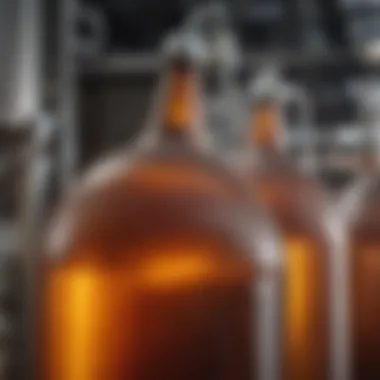Crafting Beer: Mastering the Brewing Process


Intro
Crafting beer is an age-old craft that has continuously evolved over centuries. The brewing process is not simply an act of mixing ingredients; it demands understanding, patience, and attention to detail. This exploration will break down the stages of brewing, covering essential components, techniques, and equipment utilized to produce a diverse range of beer styles.
Understanding brewing is beneficial for both amateur brewers and seasoned enthusiasts. The information gathered here aims to simplify complex methods. Knowledge of ingredients and their significance can enhance the overall brewing experience. Furthermore, the discussion incorporates the scientific principles surrounding fermentation and flavor enhancement. This provides a deeper appreciation for the intricacies involved in creating a quality brew.
Recipe Overview
The selection of a beer recipe forms the foundation of the brewing process. It defines the style, flavor profile, and aroma of the final product. By understanding the recipe, brewers can tailor their approach and techniques accordingly.
Recipe Name and Description
While there can be numerous recipes, one popular example is the classic American Pale Ale. This style combines a moderate malt backbone with distinct hop flavors. The American Pale Ale is characterized by its golden to amber color and appealing hoppy aroma.
Cuisine Type
American Pale Ale tends to be associated with American cuisine due to its roots and popularity in craft beer culture.
Ingredients List
The journey of brewing begins with the selection of quality ingredients. Each component contributes to the beer's unique characteristics. Below is a detailed look into the fundamental ingredients necessary for creating a quality brew.
Detailed Ingredient Breakdown
- Malted Barley: This is the primary source of fermentable sugars. Different malts can influence color and flavor.
- Hops: These are used for flavoring and aroma. Various hop varieties can add floral, citrus, or earthy notes to the beer.
- Yeast: The microorganism responsible for fermentation. Different yeast strains produce varying flavor profiles.
- Water: Often overlooked, water chemistry can greatly affect the brewing process. The pH and mineral content influence the final taste.
Substitutions for Dietary Needs
Brewing can accommodate various dietary restrictions. Here are some possible substitutions:
- Gluten-Free Malts: For those with gluten intolerance, malts can be sourced from sorghum, rice, or buckwheat.
- Alternative Sugars: If avoiding traditional sugars, honey or agave syrup may serve as substitutes.
“Brewing beer is both an art and a science. Mastery requires dedication to both.”
As we move forward, each section of this exploration will further unveil the specifics of the brewing process, enriching the reader’s understanding and appreciation for the craft of beer making.
Intro to Beer Making
The art of brewing beer is a fascinating journey that combines science and creativity. Understanding the basics of beer making is crucial, as it sets the foundation for producing high-quality brews. This introduction serves as a gateway for both novices and seasoned brewers to appreciate the intricate process involved in crafting beer. The brewing process not only involves technical skills but also an understanding of ingredients and equipment.
Beer is one of the oldest beverages known to humanity, with its roots traceable to ancient civilizations. Knowledge of the history and evolution of brewing equips the brewer with context, fostering an appreciation for the craft.
Historical Overview of Brewing
Brewing beer has a rich history, dating back to at least 5,000 BCE. Archaeological evidence suggests that ancient Sumerians in Mesopotamia were among the first to brew beer. The Sumerians revered beer, even dedicating hymns to Ninkasi, the goddess of beer. As societies evolved, so did the methods of brewing.
In the Middle Ages, monasteries became centers for brewing. Monks refined brewing methods, ensuring high-quality production. They kept meticulous records, contributing to the growth of brewing as a respected craft. Each region had its unique brewing techniques and styles, often influenced by local ingredients.
The Industrial Revolution marked a significant turning point. Advancements in technology enabled mass production and distribution, allowing beer to become a staple in many cultures. Despite modern innovations, traditional methods continue to thrive, fueling the craft beer movement that emphasizes quality and originality.
The Cultural Significance of Beer
Beer serves as more than just a beverage; it is an integral component of cultural identity in many societies. Throughout history, it has fostered community and camaraderie. From local pubs to global brewing festivals, beer connects people. Various cultures celebrate beer with unique rituals, styles, and traditions.
In many parts of the world, beer is symbolic of hospitality. The act of sharing a drink fosters discussions, celebrations, and bonding. It features prominently in festivals and gatherings, enhancing the connection between individuals.
Understanding the cultural context of beer enriches the brewing experience. It encourages brewers to experiment and create distinctive beers that resonate with their communities. Additionally, the blending of cultures through brewing leads to innovations, resulting in new styles and flavors that continue to enthrall beer lovers.
"Beer is proof that God loves us and wants us to be happy." - Benjamin Franklin
Understanding the Basic Ingredients


The brewing process is fundamentally rooted in four key ingredients: water, malt, hops, and yeast. Each of these components has distinct roles and characteristics that significantly influence the final product. Understanding these ingredients is crucial for anyone interested in brewing beer, whether for personal enjoyment or professional endeavors.
Water: The Foundation of Beer
Water serves as the primary solvent in the brewing process and its importance cannot be understated. About 90% of beer is water, hence its quality directly affects the flavor and overall characteristics of the brew. The mineral content of water varies widely by location and can enhance or detract from the taste of the beer.
Brewers must consider hardness, pH, and specific mineral profiles when selecting water. For instance, a high sulfur content may accentuate the hop flavors, while lower mineral content may create a softer, more subdued taste. It is advisable to use filtered water to avoid unwanted contaminants that can lead to off-flavors.
Malt: The Soul of Brewing
Malt, typically derived from barley, is crucial for providing fermentable sugars, coloring, and flavor to the beer. The malting process involves soaking grains in water, allowing them to germinate, and then drying them in a kiln. Different types of malt yield varying flavors and colors, ranging from light and sweet to dark and roasted.
The choice of malt influences the beer’s body, sweetness, and richness. Base malts provide the sugar needed for fermentation, while specialty malts contribute complexity and depth. For example, using a crystal malt can add caramel notes, whereas roasted malts can impart chocolate or coffee flavors. Understanding how to balance these malts is essential for crafting a well-rounded beer.
Hops: The Flavor Enhancer
Hops are the flowers of the hop plant and play a vital role in beer making, primarily as a flavor enhancer and preservative. They contribute bitterness, aroma, and flavor that intricately balance the sweetness of the malt. Different hop varieties offer a unique spectrum of flavors, ranging from earthy and floral to citrus and fruity.
Adding hops at various stages of the brewing process influences the final flavor profile. For instance, bittering hops are added during the boil, while aroma hops are added later to preserve their flavorful oils. Understanding the timing and type of hops can significantly elevate a beer’s complexity and enjoyment.
Yeast: The Fermentation Agent
Yeast is the driving force behind fermentation, where it metabolizes sugars from malt into alcohol and carbon dioxide. Various yeast strains, such as Saccharomyces cerevisiae and Saccharomyces pastorianus, can produce different flavor profiles. Some yeasts may impart fruity esters or spicy phenols, further diversifying the beer experience.
Controlling fermentation temperature and conditions is crucial. Higher temperatures can result in more esters and phenols, while lower temperatures yield cleaner profiles. Yeast health and viability must also be monitored for optimal fermentation, making it one of the most important elements in the brewing process.
Important Note: Successful brewing combines knowledge of ingredients with attention to detail in the brewing process itself. Each element interplays, shaping the overall character of the beer.
Understanding these basic ingredients not only enriches the brewing experience but also equips brewers with the knowledge needed to create a diverse range of beer styles. This foundational knowledge is key to experimentation and innovation in the craft of brewing.
Essential Brewing Equipment
In the journey of crafting beer, the choice of equipment plays a crucial role in transforming raw ingredients into the final product. Each type of equipment serves a specific purpose, ensuring that the various stages of the brewing process run smoothly. Understanding the essential brewing equipment not only helps in achieving consistency but also elevates the quality of the brew. Here, we explore the key components that every brewer should consider when setting up their brewing operation.
Brew Kettle: The Heart of Brewing
The brew kettle is arguably the most critical piece of equipment in the brewing process. Its primary function is to boil the wort, which is the liquid extracted from the mash. During this stage, hops are added for bitterness and aroma, impacting the beer's overall flavor. The size and material of the kettle can vary. Stainless steel is favored for its durability and ease of cleaning, while aluminum kettles are lightweight and economical.
In addition to the material, the kettle's volume should be appropriate for the batch size. A larger kettle allows for boiling of more wort at once, which is beneficial for higher production. Some brewers may opt for kettles with built-in temperature gauges or sight glasses for monitoring liquid levels, which enhance precision during the brewing process.
Fermenter: Where Magic Happens
After boiling, the wort needs to cool and be transferred to a fermenter. This vessel is where fermentation occurs, and yeast transforms sugars into alcohol and carbon dioxide. Fermenters come in many shapes and sizes, including glass carboys, plastic buckets, and conical fermenters.
Choosing the right fermenter is essential. Glass carboys are excellent for observing the fermentation activity, while conical fermenters allow for easier yeast management and are often preferred for larger batches. It is also crucial to ensure that the fermenter is sealed properly to prevent contamination. The fermentation phase can last several days to weeks, so maintaining clean equipment is vital to avoid off-flavors.
Bottling Supplies: Preparing for Presentation
Once fermentation has completed, bottling is the next step. This requires various supplies, including bottles, caps, and a capper. Glass bottles are the most common choice, but plastic bottles can be convenient for beginners or smaller batches.
It is important to sanitize all bottling equipment thoroughly. This ensures that the beer's flavor is not impacted by unwanted bacteria. The process of bottling also requires careful attention to carbonation, which can be achieved through priming sugars. This technique encourages the yeast to produce carbon dioxide, giving the beer its fizz. Proper labeling of bottles can also enhance presentation, letting consumers know about the unique style of beer inside.
Temperature Control: Ensuring Consistency
Temperature control is a fundamental aspect of the brewing process. Yeast activity is sensitive to temperature, and fluctuations can lead to undesirable results. It is vital to maintain a steady environment throughout fermentation to achieve the desired flavor profile.
Many brewers implement temperature-controlled fermentation chambers or units. These systems can be as simple as a temperature regulator with a heating belt or as complex as dedicated fermentation fridges. By maintaining the appropriate temperature, brewers have better control over the fermentation process and can prevent issues such as off-flavors or stalled fermentations.
"The right equipment can elevate an amateur batch to professional levels, ensuring that every sip is a gratifying experience."
By investing in quality equipment and understanding its importance, novice and experienced brewers can significantly enhance their beer-making skills. Each element functions together to create a brewing experience that celebrates both science and creativity.
The Brewing Process in Detail


The brewing process forms the core of beer making, intertwining art with science. Each step contributes significantly to the final product. This detailed understanding empowers brewers to enhance flavor and quality in their creations. It is vital to recognize how precision and timing play pivotal roles, ensuring that brews exhibit desired characteristics. The following sections break down each critical phase in the process, providing essential insights for both newcomers and seasoned brewers alike.
Mashing: Extracting Sugars
Mashing is the first significant step after preparing the grains. It involves mixing crushed malt with hot water, creating a mash. This temperature-controlled process activates enzymes in the malt that break down starches into fermentable sugars. The outcome of this stage directly affects the beer's alcohol content and body. Typically, mashing takes place at temperatures between 150 to 160 degrees Fahrenheit.
One key aspect of mashing is the balance of time and temperature. Longer mashing at lower temperatures yields more fermentable sugars, while shorter times at higher temperatures can lead to a fuller-bodied beer. The result is a sweet liquid known as wort, which is then ready for boiling.
Boiling: Flavor and Stability
Boiling serves multiple purposes in brewing. Once wort is created, it is brought to a boil, usually around 212 degrees Fahrenheit. This step sterilizes the wort, ensuring that unwanted bacteria do not impact the flavor. It also allows for the addition of hops, pivotal for creating bitterness, aroma, and flavor.
Timing is crucial during the boil. Early hops contribute bitter characteristics, while later additions enhance aroma and flavor. The boil typically lasts from 60 to 90 minutes.
This stage also plays a role in Maillard reactions, which develop color and complexity. As the wort boils, unwanted proteins coagulate and can be separated out. These processes contribute significantly to the beer's clarity and stability.
Cooling: Rapid Temperature Reduction
Cooling is a critical phase that follows boiling. Once boiling is completed, the wort must be cooled down as quickly as possible. Rapid cooling minimizes risks of contamination and helps maintain the delicate flavors produced in the previous steps.
Most brewers use a heat exchanger or immersion chiller for this. The goal is to drop the temperature to the range suitable for fermentation, typically around 65 to 75 degrees Fahrenheit for ales and 45 to 55 degrees Fahrenheit for lagers.
Quick cooling showcases the importance of modern brewing techniques, reducing the time between boiling and fermentation. This phase is not merely temperature adjustment; it is a necessary action that safeguards the integrity of the brew.
Fermentation: Yeast Takes Charge
Fermentation is the transformative phase where yeast turns sugars into alcohol and carbon dioxide. The cooled wort is transferred to a fermenter, where yeast is pitched. The yeast will consume the sugars extracted during mashing, leading to the creation of ethanol and carbonation.
Fermentation duration depends on the yeast strain and beer style, ranging from a few days to a couple of weeks. Temperature control and oxygen management during this phase are paramount. Yeast health directly influences the beer's flavor profile. For instance, warmer fermentation temperatures can generate fruity esters, while cooler ones provide cleaner tastes.
Conditioning: Developing Flavor Complexity
The conditioning phase follows primary fermentation. This process allows flavors to meld and mature. It generally occurs for several weeks to months and can take place either in the same fermenter or in a secondary vessel. During conditioning, off-flavors from fermentation can dissipate, leading to a smoother and more refined final product.
Brewers may choose to add additional ingredients during conditioning, including fruits or spices, to introduce unique flavors. The importance of clarity often leads brewers to employ fining agents. Fermentation and conditioning are interlinked; each impacts flavor attributes in distinct ways, underscoring the importance of patience in crafting beer.
"Brewing is not just a science, but an art driven by patience and refinement."
Understanding the brewing process in detail allows both novice and experienced brewers to navigate and perfect their craft. Each phase contributes uniquely to the characteristics of the final product, ensuring that the end result is not just a drink, but an experience.
Different Beer Styles and Their Characteristics
Understanding different beer styles is crucial in brewing. Each style offers unique flavors, aromas, and mouthfeels. This section will delve into these categories. It helps amateur and experienced brewers recognize the vast palate of beer possibilities. By knowing the characteristics, brewers can craft beers to suit varied tastes. Style knowledge can also inspire creativity in recipe formulation.
Ales: Diverse and Fruity
Ales are known for their diverse flavor profiles and fruity aromas. They are fermented with top-fermenting yeast, which operates at warmer temperatures. This fermentation process enhances fruity esters and phenols. Common ale styles include pale ale, India pale ale (IPA), and brown ale. Each type has distinct grain bills and hopping techniques, allowing for a broad range of taste experiences.
For instance, an IPA often features robust hop flavors that impart citrus and pine notes. In contrast, a brown ale boasts malty sweetness with hints of caramel and chocolate. Understanding these nuances allows brewers to tailor flavors to their desired outcome. Ale diversity is significant, making this category popular among craft beer drinkers.
Lagers: Crisp and Clean
Lagers, in contrast to ales, use bottom-fermenting yeast. They are fermented at cooler temperatures, resulting in a clean, crisp taste. The lagering process, where beer ages at low temperatures, improves clarity and smoothness. Styles such as pilsner and helles are classic examples. Each has its own profile, balancing malty sweetness with hop bitterness.
Pilsners usually showcase a floral hop aroma, while helles maintains a mild malt character. This distinction is paramount for brewmaster’s creations. Beyond taste, lagers tend to appeal to those who prefer subtle flavors. A solid grasp of lager characteristics enhances one's ability to create refreshing brews.
Stouts and Porters: Rich and Complex
Stouts and porters are celebrated for their rich, dark profiles. They utilize dark malts to achieve their deep colors and bold flavors. The process often emphasizes roasted characteristics such as coffee, chocolate, and caramel. Variations, like oatmeal stouts and milk stouts, introduce smoothness and creaminess. Porters tend to have a slightly lighter body but possess robust flavors as well.
Understanding the distinctions in grain and hopping techniques can help brewers manipulate these flavors. For instance, the inclusion of lactose in a milk stout adds sweetness. This complexity appeals to drinkers seeking depth in their beer experiences.


Sours and Wild Ales: Experimentation in Flavor
Sour beers represent a departure from traditional brewing styles. They experience wild fermentation through bacteria and wild yeast, leading to tartness and a range of flavors. Such beers can vary significantly in character, from subtly sour to heavily acidic. Common styles include Berliner Weisse and lambic.
Brewers often experiment with fruits, spices, and barrel-aging techniques. This experimentation allows exploration of unique flavor profiles. Souring can create unexpected wellness benefits as well. Understanding these styles aids brewers in pushing boundaries within their craft, appealing to adventurous drinkers.
Troubleshooting Common Brewing Issues
In the realm of homebrewing, technical challenges often arise that can affect the quality of the final product. Understanding these common issues and knowing how to address them is crucial for both novice and seasoned brewers. Troubleshooting problems in brewing not only enhances your brewing skills but also ensures that the beer produced meets expectations. Resolving issues can turn potential failures into successful brews, ultimately increasing confidence in one's brewing capabilities.
Off-Flavors: Identification and Solutions
Off-flavors in beer can undermine the intended taste profile, much to a brewer's dismay. There are several common off-flavors that can occur during brewing, including:
- Diacetyl: A buttery flavor resulting from improper yeast handling.
- Acetaldehyde: Often described as tasting like green apples, this can occur due to insufficient fermentation time.
- Oxidation: Sometimes imparting a sherry or cardboard-like taste.
The key to addressing off-flavors begins with proper identification. Recognizing the symptom is half the battle. For example, the presence of diacetyl can often be minimized by ensuring a proper fermentation temperature and allowing the beer to rest on the yeast for a few days post-primary fermentation. Reducing oxygen exposure during bottling is vital to combat oxidation.
To solve these issues:
- Maintain strict temperature control during fermentation.
- Ensure yeast is healthy and properly pitched.
- Adequate racking and packaging techniques can prevent exposure to oxygen.
Low Carbonation: Causes and Remedies
Low carbonation can leave beer feeling flat and unappealing. This issue can occur for various reasons, such as insufficient priming sugar, incomplete fermentation, or even issues with bottling. Low carbonation can be particularly disappointing for styles that rely on a lively mouthfeel.
Common contributors to low carbonation include:
- Under-pitching yeast: Not providing enough yeast can inhibit proper fermentation.
- Cold temperatures during conditioning: Yeast may not be active enough to carbonate the beer adequately.
To remedy low carbonation, brewers might try:
- Increase priming sugar before bottling to encourage carbonation.
- If bottle conditioning has occurred, gently agitating the bottles can help dissolve any remaining sugar.
- Monitor fermentation and ensure yeast is healthy and active before bottling.
Contamination: Prevention Tips
Contamination can lead to undesirable flavors and aromas in beer. Various microorganisms, such as wild yeasts or bacteria, can infiltrate the brewing process. Identifying contamination is serious. In many cases, it can ruin a batch completely.
The best way to avoid contamination is through sanitation. Here are key strategies:
- Sanitize equipment before and after each use. This is perhaps the most crucial step in brewing.
- Control environment. Keep brewing areas clean and free from unwanted pests or debris.
- Use high-quality ingredients to minimize the risk of introducing contamination.
By focusing on sanitation and cleanliness, homebrewers can greatly reduce the risk of contamination, allowing for a more successful brewing process.
Patience and attention to detail are critical in the brewing process. Avoiding common issues requires understanding, practice, and dedication.
End: The Art of Patience in Brewing
In the realm of brewing, patience is not merely a virtue; it is a substantial part of the entire process. The act of brewing beer can be seen as a meticulous journey, where each stage demands attention and time. The fermentation stage, in particular, highlights the importance of this principle. Yeast requires an appropriate environment to thrive and produce the desired flavors, which does not happen instantly. Rushing this phase can result in off-flavors or an incomplete brew, ultimately leading to disappointment.
Another key aspect of patience encompasses the entire journey of a brewer. From selecting quality ingredients to mastering specific techniques, every step plays a pivotal role in the brewing outcome. Waiting for flavors to develop during conditioning is equally important. Many brewers often rush to crack open their bottles too soon, overlooking how subtle complexities take time to emerge and mature.
Patience in brewing cultivates more than just a better final product; it enhances the brewer's understanding of the craft. With every batch, lessons are learned and skills are refined, contributing to a more profound appreciation for the art of beer making. “A true beer lover understands that greatness is not achieved in haste but through careful nurturing.”
Reflection on the Brewing Journey
Reflecting on the journey of brewing invokes a deep realization of how far one can progress. For many, brewing begins as a hobby, possibly prompted by curiosity or a love for craft beer. As one navigates through the various stages—researching ingredients, experimenting with recipes, and adjusting techniques—the evolution of skills becomes a testament to patience and dedication. Through each trial and error, brewing transforms from a simple activity into an intricate art form.
By looking back on earlier batches, a brewer can see the progression not only in skills but also in the personal touch in crafting beer. The experience serves as a reminder that every brew brings its own set of challenges and triumphs. Likewise, it provides insights into the flavors that are favored and different techniques that can be applied in future brewing endeavors.
Encouraging Experimentation and Innovation
As brewers become more adept, encouraging experimentation becomes crucial for growth. The willingness to try new ingredients, techniques, or styles can unearth amazing possibilities. Innovation in brewing can lead to remarkable flavors and unique beer profiles. While it is essential to respect traditional methodologies, thinking outside the box can provoke exhilarating results.
Experimentation can take many forms. It may include the addition of unconventional ingredients like spices, herbs, or even fruits during brewing. This approach not only fosters creativity but also stimulates the development of new styles that challenge existing norms in the beer industry.
Brewers should also consider documenting their trials. This practice allows for analysis of outcomes and provides a reference for future experiments. Engaging with other brewers also promotes the exchange of ideas and techniques. Sharing results in forums or communities can inspire a new generation of brewers.
To conclude, the art of patience in brewing not only enhances the brewing journey but also connects brewers across time and space. It bridges the gap between tradition and innovation, creating a vibrant community that celebrates both the science and pleasure of beer making.















